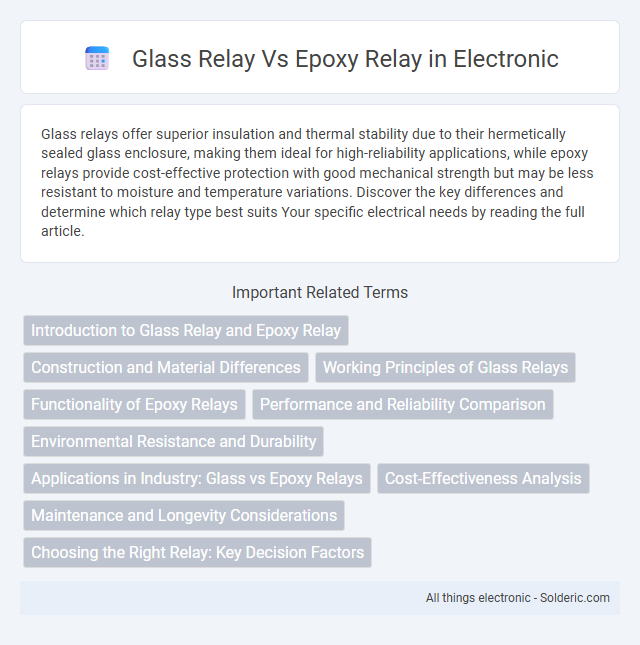Glass relays offer superior insulation and thermal stability due to their hermetically sealed glass enclosure, making them ideal for high-reliability applications, while epoxy relays provide cost-effective protection with good mechanical strength but may be less resistant to moisture and temperature variations. Discover the key differences and determine which relay type best suits Your specific electrical needs by reading the full article.
Comparison Table
| Feature | Glass Relay | Epoxy Relay |
|---|---|---|
| Encapsulation Material | Glass | Epoxy Resin |
| Durability | High resistance to moisture and contaminants | Good mechanical strength, moderate moisture resistance |
| Thermal Stability | Excellent heat resistance | Moderate heat resistance |
| Electrical Insulation | Superior insulation due to glass enclosure | Effective but less than glass |
| Cost | Generally higher | More affordable |
| Application | High-reliability electronics, sensitive circuits | General purpose, consumer electronics |
| Size & Weight | Typically compact and lightweight | Variable, sometimes bulkier |
Introduction to Glass Relay and Epoxy Relay
Glass relays feature a hermetically sealed glass enclosure that offers superior protection against moisture, dust, and contaminants, enhancing reliability in precision applications. Epoxy relays use an epoxy resin casing, which provides good insulation and mechanical strength but may be less resistant to harsh environmental conditions. Your choice between glass relay and epoxy relay depends on the required durability, environmental resistance, and application sensitivity.
Construction and Material Differences
Glass relays use a sealed glass envelope to encase the coil and contacts, providing superior visibility and protection against environmental contaminants. Epoxy relays feature a solid epoxy resin casing that offers enhanced mechanical strength and resistance to vibration but limits internal component visibility. The glass material promotes better insulation and heat dissipation, while epoxy compounds improve durability and sealing against moisture.
Working Principles of Glass Relays
Glass relays operate by enclosing the internal components within a hermetically sealed glass enclosure, protecting the contacts from contamination and ensuring reliable switching through electromagnetic actuation. This sealed environment enhances performance by reducing oxidation and increasing the relay's lifespan compared to standard epoxy relays, which use a resin encapsulation. Understanding the working principles of glass relays helps you choose the ideal relay for applications requiring high reliability and durability in harsh conditions.
Functionality of Epoxy Relays
Epoxy relays provide reliable electrical insulation and environmental protection by encapsulating components in a durable resin, enhancing resistance to moisture, dust, and mechanical stress. This encapsulation ensures stable functionality in harsh conditions, making epoxy relays ideal for industrial and automotive applications. Their robust construction supports high dielectric strength and thermal management, contributing to extended relay lifespan and consistent performance.
Performance and Reliability Comparison
Glass relays exhibit superior insulation resistance and thermal stability, making them highly reliable for high-frequency and high-voltage applications. Epoxy relays, while more cost-effective, tend to have lower thermal endurance and may be prone to moisture ingress, impacting long-term performance. Your choice should consider the criticality of environmental conditions and required lifespan to ensure optimal reliability and consistent performance.
Environmental Resistance and Durability
Glass relays offer superior environmental resistance due to their hermetically sealed glass enclosure, which protects internal components from moisture, dust, and corrosive elements, ensuring long-term reliability in harsh conditions. Epoxy relays, while more cost-effective, typically feature resin-encapsulated housings that may degrade over time when exposed to extreme temperatures, chemicals, or humidity, potentially compromising durability. The glass enclosure in glass relays significantly minimizes contamination risks and enhances insulation integrity, making them more suitable for applications requiring high environmental resilience and extended service life.
Applications in Industry: Glass vs Epoxy Relays
Glass relays are preferred in high-frequency and high-reliability applications such as aerospace, medical devices, and precision instrumentation due to their hermetic sealing and resistance to contaminants. Epoxy relays are commonly used in consumer electronics, automotive, and industrial control systems where cost efficiency and mechanical robustness are prioritized. The choice between glass and epoxy relays depends on environmental exposure, desired durability, and electrical performance requirements in specific industrial settings.
Cost-Effectiveness Analysis
Glass relays generally offer better cost-effectiveness due to their lower manufacturing costs and simpler construction compared to epoxy relays. Epoxy relays provide enhanced durability and resistance to environmental factors but at a higher price point, making them more suitable for high-reliability applications rather than budget-sensitive projects. Evaluating total lifecycle costs, including maintenance and failure rates, is critical to determining the most economically viable relay type for specific use cases.
Maintenance and Longevity Considerations
Glass relays offer superior longevity and require minimal maintenance due to their hermetically sealed design, which protects internal components from environmental contaminants and moisture. Epoxy relays, while more cost-effective, often demand more frequent maintenance as their resin casings can degrade over time and are susceptible to moisture ingress, affecting performance and lifespan. When prioritizing your system's reliability and long-term maintenance costs, glass relays provide a more durable and low-maintenance solution.
Choosing the Right Relay: Key Decision Factors
Selecting the right relay depends on factors such as durability, environmental resistance, and application requirements. Glass relays offer excellent visibility and insulation but may be less impact-resistant compared to epoxy relays, which provide superior protection against moisture and mechanical shock. Understanding your operating environment and performance needs ensures your relay choice enhances system reliability and longevity.
Glass Relay vs Epoxy Relay Infographic

 solderic.com
solderic.com